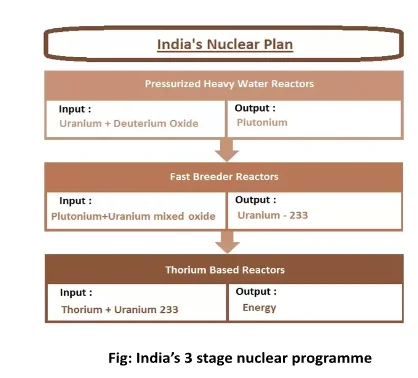Nuclear energy, derived from nuclear reactions such as fission and fusion, plays a crucial role in India’s electricity generation. As the fifth-largest source of power, it significantly contributes to the nation’s energy mix. India’s ambitious Three-Stage Nuclear Power Program, proposed by Dr. Homi J. Bhabha, aims to create a self-sustaining nuclear industry. With multiple institutions involved in research and development, India is focused on harnessing nuclear energy for peaceful and innovative applications.
The Evolution and Framework of Nuclear Energy in India
India’s Three-Stage Civil Nuclear Power Programme
- The Three-Stage Nuclear Power Program is an initiative introduced by India to develop a self-sustained nuclear power industry.
- It was proposed by Dr. Homi J. Bhabha, the founder of India’s nuclear program, in the 1950s.

Nuclear Power In India
- Nuclear energy is the fifth-largest source of electricity in India, contributing about 3% of the country’s total electricity generation.
-
- Installed capacity: 6,780 MW (as of November 2023)
- Number of reactors: 22 operating reactors across 7 nuclear power plants
- Types of reactors: Primarily pressurized heavy-water reactors (PHWRs), with some light-water reactors (LWRs)
- Contribution to electricity generation: Approximately 3.11% (as of 2020-21)
- Plans for expansion: Increase nuclear power capacity to 22,480 MW by 2031, accounting for nearly 9% of the energy mix by 2047.
Institutions Involved In Nuclear Energy R & D
- Department of Atomic Energy: The Department of Atomic Energy (DAE) is a government agency in India responsible for the development and implementation of nuclear energy programs.
- The DAE operates under the Prime Minister’s Office (PMO), under the oversight of the Prime Minister of India.
-
- Its function is to harness nuclear power, foster research and development, and ensure safety and regulations.
Bhabha Atomic Research Centre(BARC)
Establishment: Established in 1954, It is a premier multidisciplinary nuclear research facility located in Trombay, Mumbai, India.
- Objective: The primary objective of BARC is to harness nuclear energy for peaceful applications and conduct research across various scientific disciplines.
Global Centre For Nuclear Energy Partnership
It serves as a vital platform for international collaboration and innovation in the field of nuclear energy.
-
- Objective: Established in 2010 by the Department of Atomic Energy (DAE) in India, GCNEP aims to address global energy challenges through research and development in advanced nuclear technologies.
- GCNEP fosters collaboration through various mechanisms:
-
- Joint research projects: GCNEP collaborates with international research institutions and universities on specific projects.
- Expert Exchanges: GCNEP facilitates the exchange of experts and knowledge between different countries.
- Training Programs: GCNEP offers training programs for scientists, engineers, and policymakers from developing countries.
- Workshops and Conferences: GCNEP organizes international workshops and conferences to share knowledge and discuss emerging trends in nuclear energy.
Atomic Minerals Directorate for Exploration and Research
The Atomic Minerals Directorate for Exploration and Research (AMD) is an Indian government organisation responsible for exploring, assessing, and researching atomic minerals in the country.
- It operates under the Department of Atomic Energy (DAE), which is a key governmental agency overseeing nuclear energy programs in India.
- AMD has its headquarters in Hyderabad, Telangana, and it operates through regional centers across the country to cover different geological regions.
India’s Nuclear Power & Energy Policy
India’s nuclear power and energy policy reflects a complex balancing act between diverse priorities and challenges.
- Pillars of India’s Nuclear Policy
-
- No First Use (NFU): India’s policy commits it to never initiating a nuclear attack, even in the face of conventional aggression.
- Credible Minimum Deterrence: This aims to maintain a nuclear arsenal sufficient to deter any potential adversaries from launching a nuclear attack against India.
- Peaceful Use of Nuclear Energy: India emphasizes the peaceful use of nuclear energy for power generation and medical applications.
Command And Control Of Nuclear Bombs
Command and control of nuclear weapons is the authority and direction exercised by the President over nuclear weapon operations.
- Nuclear Command Authority (NCA): On January 4, 2003, the Nuclear Command Authority (NCA) was established by the Cabinet Committee on Security (CCS), comprising two councils: the Executive Council and the Political Council.
-
-
- Chaired by the National Security Advisor (NSA), the Executive Council works in tandem with the Political Council, which is chaired by the Prime Minister.
- Strategic Nuclear Command or Strategic Forces Command: The Strategic Nuclear Command is an integral component of India’s Nuclear Command Authority (NCA), formally established in 2003.
-
- The Joint Services Strategic Nuclear Command (SNC) serves as the custodian for all of India’s nuclear weapons, missiles, and assets.
- It bears responsibility for the execution of all aspects of India’s nuclear policy.
Conclusion
India’s nuclear energy sector is poised for substantial growth, with plans to significantly increase its capacity by 2031.
- The country’s comprehensive nuclear policy emphasizes peaceful energy use, minimal deterrence, and a no-first-use stance. With robust institutions and international collaborations, India continues to advance in nuclear technology.
- Ongoing research and strategic initiatives ensure that nuclear energy remains a vital part of India’s future energy landscape.
![]() June 14, 2024
June 14, 2024
![]() 1771
1771
![]() 0
0
